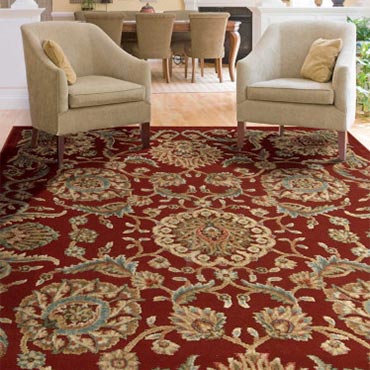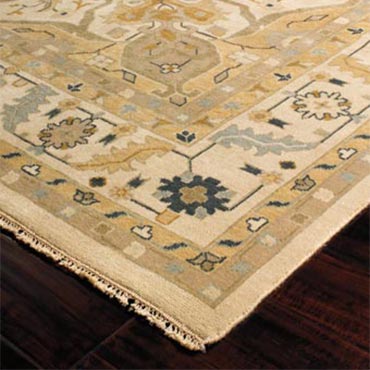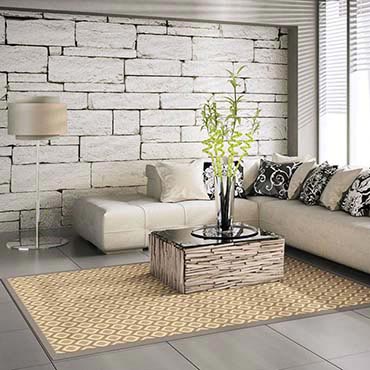Kathy Ireland's rugs are beautiful, durable, machine-crafted of plush 100% polypropylene in a Wilton woven construction inspired by her travels all over the world. Learn More
Oriental Rugs
Oriental Rugs Guide
 Oriental Rugs are hand-knotted carpets originally from the cultural rich regions of the Middle East, Central Asia, and the Far East. These rugs are highly prized for their intricate designs, meticulous craftsmanship, and vibrant colors. Made traditionally from silk, wool, or cotton, Oriental rugs often feature complex patterns that include floral motifs, geometric shapes, and medallions, each with symbolic meanings. The dyeing techniques and quality of materials ensure that each rug is both a work of art and a durable floor covering. Oriental rugs are revered for their ability to add a touch of luxury and elegance to any space, blending seamlessly with both traditional and contemporary interiors, making them a timeless investment for home decor.
Oriental Rugs are hand-knotted carpets originally from the cultural rich regions of the Middle East, Central Asia, and the Far East. These rugs are highly prized for their intricate designs, meticulous craftsmanship, and vibrant colors. Made traditionally from silk, wool, or cotton, Oriental rugs often feature complex patterns that include floral motifs, geometric shapes, and medallions, each with symbolic meanings. The dyeing techniques and quality of materials ensure that each rug is both a work of art and a durable floor covering. Oriental rugs are revered for their ability to add a touch of luxury and elegance to any space, blending seamlessly with both traditional and contemporary interiors, making them a timeless investment for home decor.Disclaimer: The information provided in this article is for general informational purposes only. While we strive to ensure the accuracy and reliability of the information presented, we make no warranties, express or implied, about the completeness, accuracy, reliability, suitability, or availability with respect to the content. Any reliance you place on such information is strictly at your own risk. We recommend consulting with professionals for specific advice tailored to your project’s needs, particularly regarding building codes, regulations, and product specifications.
Under no circumstances shall we be liable for any loss or damage, including without limitation, indirect or consequential loss or damage, arising from the use of, or reliance on, the information provided in this article.
Select Product Sub-Category:
Oriental Rugs
Top 1 Types of Oriental Rugs
 Area Rugs - 386 Chinese RugsThe centuries-old Chinese textile industry is rich in history. While most antique carpets are classified according to a specific region or manufactory, scholars attribute the age of any specific Chinese rug to the ruling emperor of the time. Learn More |
Featured Brands
The Best 6 Oriental Rugs Brands


Nourison Oriental Rugs
Profile | Website | Maintain | BlogOriental-inspired arabesques and blossoms grace this utterly elegant area rug in regal hues of sky, white, rose, olive, russet and pale gold. Detailed hand carving and a high-low loop pile construction create a marvelous tone and texture. Learn More

Masland Oriental Rugs
Profile | Website | What's New | WarrantyTimeless patterns join with harmonious colors to create the Heirloom Collection by Masland Carpets and Rugs. Six hand-knotted wool rugs exhibit the beauty of a far away land and provide the look and feel of a cherished antique. Working in concert, skilled artisans spend up to four months crafting each rug with hand spun yarn. Learn More

Karastan Oriental Rugs
Profile | Website | Video | Brochure | Tips | Warranty | MaintainThis scrolling vine and blossom design of this oriental style rug is punctuated with oversize palmettes and serrated leaves typical of both Agra and Lahore carpets woven during the mid 17th century Mogul dynasty. Learn More

STANTON Rugs
Profile | Website | CleanStanton Rug's predominantly wool product line features high quality, designer-driven patterns and styles. Stanton produces a number of decorative, high-quality, specialty collections of needlepoint Wiltons and decorative patterns in nylons spanning from residential to medium commercial applications. Learn More

United Weavers
Profile | WebsiteUnited Weavers of America brings decades of experience and service to the home furnishings space. Our products & materials are meticulously selected for quality, durability, style & comfort. Most of our expert staff was recruited from the floor covering industry bringing a world of experience and are still with us today. Learn More
Oriental Rugs Videos
The Top 1 Oriental Rugs Videos
Central Oriental Rugs Handmade Acrylic Carpet
Oriental Rugs News
Latest Oriental Rugs News
Oriental Rugs...Oriental rugs are fine crafted rugs that contribute nicely to any formal or informal setting in your home. Open virtually any magazine on decorating and you'll find Oriental rugs used as integral part of the decor. Oriental rugs blend wonderfully with contemporary, formal, ornate, casual and traditional decorating styles. Oriental rugs are as adaptable to the casual living styles of today as to... |
Area Rugs...m one wall to another, and is typically not even attached as part of the floor. Area Rugs can be produced on a loom quite similar to woven fabric, made using needle felts, knotted by hand (in oriental rugs), made with their pile injected into a backing material (called tufting), flatwoven, made by hooking wool or cotton through the meshes of a sturdy fabric or embroidered. Carpet is common... |
Hand-Made Rugs...is attached to the warp by one of three knot types (see below), such as shag carpet which was popular in the 1970s, to form the pile or nap of the carpet. Knotting by hand is most prevalent in oriental rugs and carpets. Kashmir carpets are also hand-knotted. Pile carpets, like flat carpets, can be woven on a loom. Both vertical and horizontal looms have been used in the production of Europe... |
Persian Rugs...For many people the term "Persian rug" is synonymous with oriental rugs in general. Certainly the variety of Persian rugs, from the sophisticated larger versions made by master weavers to the smaller but no less charming nomadic Persian rugs, is extraordinary. The colorings of Persian rugs are invariably rich and deep, usually with a ground of crimson backing symbolic, figurative or naturalisti... |
Wool Rugs...way or living room, take care to choose one that is going to be able to withstand the test of time. Although wool is known for its toughness, some applications, particularly those used to manufacture oriental rugs, use very long fibers which are not always practical for area rugs that have to withstand a large amount of human traffic. |






